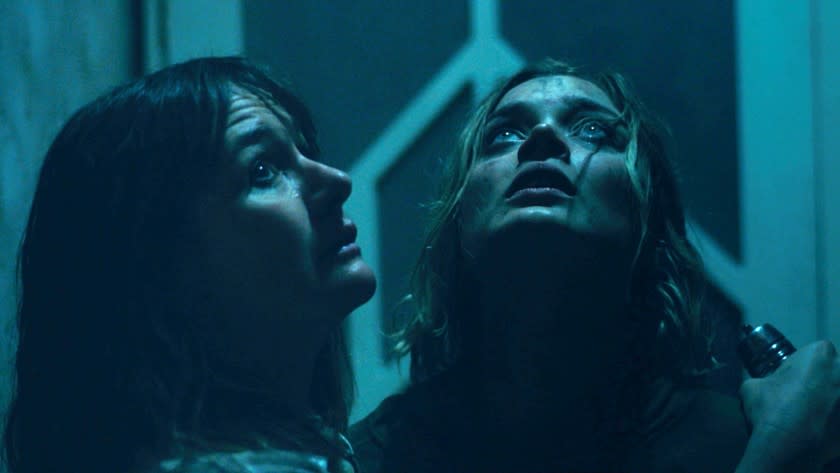Emily Mortimer explains the 'extraordinary and bizarre' ending of 'Relic'

Warning: This story contains spoilers about the final scene of "Relic." It is intended for those who have seen the film. If you'd like to read some non-spoiler-y "Relic" content, check out this interview with director Natalie Erika James and this Geoff Berkshire review.
Natalie Erika James' claustrophobic horror "Relic" ends in an unexpected way: Despite finally managing to break free from the grip of a house haunted by pestilence, our two protagonists choose to go back in.
"For me, it's a very hopeful ending and optimistic in some sense," said the director, who co-wrote the script with Christian White. After an hours-long struggle to disentangle themselves from a labyrinthine house engulfed in sinister black mold, Kay (Emily Mortimer) and Sam (Bella Heathcote) choose to return to the bedside of Edna (Robyn Nevin), whose encroaching Alzheimer's has swallowed not just her mind but her body.
"It's always been so important to me that we have a lot of empathy for Edna and what she's going through, because that's certainly how you feel when you have a loved one who is losing parts of themselves," James said. "I would really recoil at the idea that people would read it as her simply being evil or something like that."
"I really want the audience to have somewhat of a cathartic experience," she added. "My attempt with this film was to really sum up the essence of the experience [of death and decline] emotionally. And if it helps someone process the experience in a new way or helps them conquer that fear, that would be pretty amazing."
In the final scene, the mold — which is representative of Edna's deterioration as well as the threat of abandonment itself — spreads beyond the matriarch, who has shriveled up under the weight of it, to her daughter, Kay, in a scene that is equal parts terrifying and emotional. "That last beat," Mortimer said, "when you see it on me you realize, 'Yeah, this isn't just a freak occurrence; this is all of our ends.'"
The Times caught up with the actress before the film's release on video on demand and in select theaters to talk us through that "extraordinary and bizarre" ending.

What was your first impression when you read the scene on the page?
The last 10 pages or so of the script was so extraordinary and bizarre and resonated really strongly. It was like nothing I'd ever imagined before — but was also really familiar and shocking and beautiful. I just felt, "Oh, this is really audacious and wonderful." I mean, I don't think there's anything more horrifying in life than watching someone you love die. That's more scary than anything you could see in a movie. Yet it also has this cathartic depth and beauty and strangeness to it as well. I think the film really captured that in an incredibly lyrical way, as well as being terrifying and almost hilariously scary at times.
Can you imagine an alternative ending for the film?
No. I think that scene kind of is the movie, in a way, or [at least] the perfect culmination of the movie. Watching people you love die, or go on this journey before they die where they become something that is not familiar to you — especially when dementia or Alzheimer's takes over — is really horrifying. It's both this mental and physical decline that you're part of and [witness to]. It's like they're being taken over by something. And I feel that the ending really reflects that physical disintegration.
What was it like filming the scene?
It was really amazing filming it. One of the most impressive parts of the movie, for me, is how everything was made on so little money and with so little CGI. Everything was just so exquisitely and beautifully made. That puppet creature was animatronic and was just so beautiful. It was like a baby or something, but a baby with this old face. It was [expletive] mad but really, really moving and sort of lo-fi at the same time. But I stank of the plastic and fake blood; it's a very weird smell.
I think the moment where I decide to go back into the house and I can't leave, that felt really recognizable of [the feeling] when everything in you wants to run away but you can't. And this horrifying thing that has been so scary and bizarre suddenly becomes something you can look in the eye. You can sort of help the person that you love go, and it suddenly is kind of peaceful and beautiful and OK. That ritualistic peeling off of the final layers of the creature was very symbolic of that in a way that felt incredibly right.
Death is unavoidable in horror, but this film is rare in its decision to consider death not only through the lens of fear but with acceptance. Why do you think we continue to be so fearful of an inevitability as old as time?
I feel like we've almost been in denial about the one inevitable fact of all our lives, which is that we're going to die. Our Western culture has been a bit scared to confront that. It's almost like it might not happen if you go to the shrink and do your exercises or your yoga and you take your pill and drink your wheatgrass. And then there is a terrible shock when it does [happen]. I just think that really looking at the thing itself, not just getting Alzheimer's and getting old and how difficult that is, but the actual journey that people take when they die, it's a very underexplored thing that I felt the movie was really looking in the face. And that's incredibly relevant right now.

